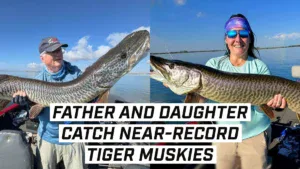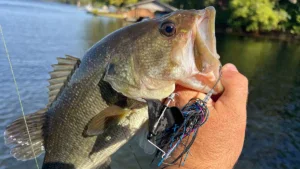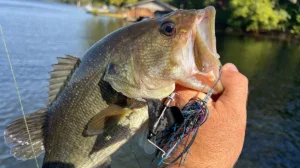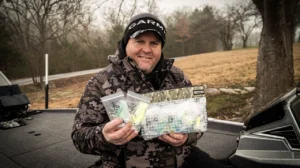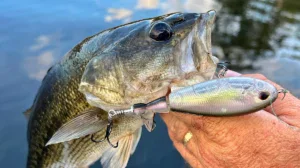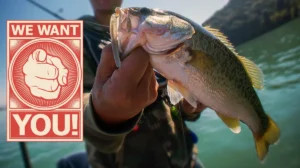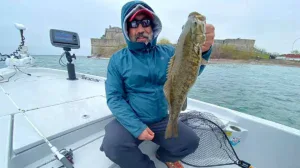Two decades of fishing history in the making, TPE baits are trending in a big way. But what exactly is TPE? What are its benefits over traditional PVC soft plastics? And more to the point, as knock-off TPE baits continue arriving from overseas, why do the original made-in-the-USA TPE baits — known as ElaZtech — remain superior in underwater action, longevity and strike generation?
The story began shortly after the arrival of the new millennium. Creative minds at the lab of an anonymous South Carolina tackle company known as Z-Man began quietly concepting an exciting new softbait recipe with intriguing possibilities. The mission was ambitious yet undeniably exciting: To pioneer a series of groundbreaking softbaits composed of thermoplastic elastomer (TPE) — a unique, ecologically neutral substance used in cosmetics, dog chew toys, baby bottles and medical and healthcare products.

The day the calendar flipped to 05/05/05 — following several starts, stops and reboots — the first batch of the newly perfected baits virtually crawled out of their aluminum molds.
But even for the originators of this unique, arguably superior bait formula, evolving from raw materials to finished, fishable product required a singular vision and the passion to pioneer an entirely new lure category.
Almost immediately, these exceptional next generation softbaits caught fire with the inshore saltwater community surrounding Z-Man headquarters, spreading up and down the East Coast like good news.
“Everything about ElaZtech baits, which are a highly cultivated form of TPE, scream saltwater fishing,” notes Captain C.A. Richardson, a legendary inshore guide and owner of Florida-based Flats Class Charters. “From the very beginning, we realized these were the most resilient baits we’d ever used. They move easily and freely. Stand up on bottom and mimic feeding shrimp and baitfish like no other bait. They’re incredibly soft and fish absolutely engulf them—but they can’t destroy ‘em like they do every other one-hit wonder bait.”
Curiously, perhaps akin to the initial arrival of braided superlines, the baits’ undeniable advantages weren’t immediately embraced in freshwater. Bass pros belittled both the baits and a new finesse technique called the Ned rig, that is until the resilient little morsel started winning tough-bite bass tourneys everywhere.

The legendary Ned Kehde, however, recognized the baits’ potential from the jump.
“ElaZtech baits excel because the material is exceptionally durable, allowing dozens of fish to be caught on one lure,” wrote Kehde in 2016, one year after Z-Man created the archetypal bait known as the Finesse TRD. “Moreover, the baits are supple and lifelike, and float off bottom, providing their own built-in action,”
On the tournament scene, Luke Clausen, longtime Z-Man pro and winner of both the Bassmaster Classic and FLW Cup championships, also embraced the baits from day-one.

“ElaZtech is the bait of the future, a true super plastic,” said Clausen in 2012. “Just as fluorocarbon is different than monofilament and tungsten is different than lead, ElaZtech offers some uniquely powerful properties that increasingly get the nod over conventional soft plastics.”
Formula 050505
“From early on, we were motivated by the idea of creating a bait from an environmentally benign, phthalate-free substance that outperformed traditional PVC (polyvinylchloride) baits in the water,” recalls Z-Man Operations Manager Jolee Myers, one of the key creators of the original ElaZtech formula.
“But there was no playbook for creating new baits from a state-of-the-art material. In fact, we initially realized that nothing that works with plastisol (PVC) works with ElaZtech, so Z-Man became ground zero for creating an entirely new bait formula.
“Even today, ElaZtech still amazes us. It’s really wonderful stuff, like, we sometimes wonder if it came here from another planet,” Myers laughs.
By now, most anglers are aware of the remarkable fish-friendly advantages: ElaZtech is at least 10-times more durable than traditional baits composed of PVC. Z-Man has long chronicled the endurance advantages of ElaZtech, evidenced by the 238 largemouth bass caught by the legendary Ned Kehde on a single Finesse WormZ in 2015. Or the current ElaZtech record of 255 bass and other fish, caught on a single TRD TicklerZ by Brian Waldman in August and September 2021.
You might say that during the past few years, the reputation and fish-catching prowess of ElaZtech has reached an all-time high. Anglers have embraced the baits for bass, crappie, walleye, redfish and niche species like striped bass, snakeheads, and northern pike. Internationally, ElaZtech baits have remained red hot for years. Many of the best anglers in Australia and Scandinavia turn to Z-Man superplastics for brawling predators like barramundi and pike. (A 7-inch Scented Jerk ShadZ recently caught the world record cobia off the Western Australian coast.)

Factoring Bait Softness
Eventually, perhaps predictably, the trend from traditional PVC to high performance ElaZtech spawned TPE imitations. In recent years, numerous companies have attempted to grab a piece of the pie, importing “over the counter” TPE baits made in China and Taiwan.
“Z-Man is still the only company who manufactures TPE baits in the US,” notes Z-Man President Daniel Nussbaum, suggesting several key differences between ElaZtech and its imitators. “Obviously, we’ve long supported US manufacturing, but by keeping bait production in-house, we’re also able to offer a greater diversity of bait shapes and colors and quicker turnaround times—all direct results of the instant, seamless communication between different departments operating under the same roof.”
“The great part about working with such a unique, unusual material is that it allows us to constantly innovate new formulas and ways to improve on the fishability of the baits right on site,” adds Myers. “We can control and perfect every aspect of bait making, from altering the baits’ softness and buoyancy to adding salt, scent or fine-tuning colors to the exact specifications required by anglers.”
Among the manifold advantages of producing ElaZtech baits in their US-based labs, Myers highlights Z-Man’s adaptability to tweak the formula and alter bait softness to match the situation.
“For the most part, PVC baits all exhibit the same hardness or durometer, which measures how resistant materials are to indentation,” explains Myers. “When designing a new bait, we analyze the top applications and modify the durometer to match. We believe, other factors being equal, a softer bait moves more freely and naturally. Fish bite and hold these baits longer, yet even at low (extra soft) durometers, ElaZtech baits remain amazingly resilient—which is part of their magic (baits will stretch up to twelve times their length without ripping).

“While most traditional PVC baits measure a 21 to 22 (Shore Hardness Scale), we make ElaZtech baits with a formula that ranges anywhere from 6 to 12 to 18 — orders of magnitude softer than traditional stuff. For finesse baits, we use the softest formula possible, adding salt as needed to alter buoyancy and increase hardness. The ZinkerZ, for example, starts at a 6, which is softer than a gummy bear, but the salt slides it up the scale, slightly. Some of our flipping baits, like the Gremlin, employ a harder material from 15 to 18.”
(For reference, a marshmallow measures a 10, gel shoe insoles are a 30 and rubber bands are just over 60 on the Shore 00 Hardness Scale.) Anglers who’ve fished ElaZtech baits extensively discover that fish teeth will often create tiny tears in the material.
“But what anglers soon realize is that these little cuts don’t become any bigger with time because ElaZtech is exceedingly resistant to tear migration,” adds Myers. “In fact, many anglers believe that the more our baits get chewed up by fish, the better they produce. Certainly, as fish create more of these micro cuts in the ElaZtech, baits become spongier to the touch. Anglers have also figured out that these cuts are excellent little conduits for absorbing and retaining scent, such as Pro-Cure, for long periods of time.
“Doesn’t matter if you’re fishing a dropshot, swimbait or a Ned rig,” says Clausen. “ElaZtech baits excel in every situation because they self-activate and move by themselves. Compare that to a PVC bait that falls over and lies lifeless on the bottom, and you quickly understand the allure of ElaZtech.”
“No other bait type offers so many obvious angling advantages or so many under-the-radar rewards, including new hacks and bait mods anglers continue to discover each season.”
Yet the question remains: Are all TPE baits created equal? Let’s just say 20 years, hundreds of millions of baits sold and an ever-expanding statline of fishing success equals a significant head start.

SPONSORED CONTENT


